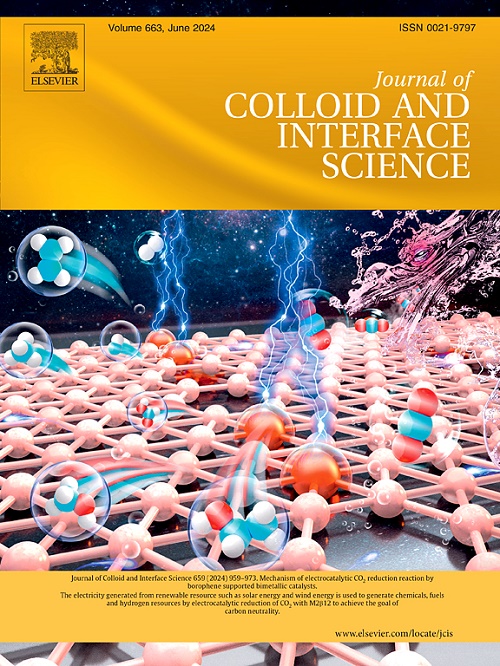双相界面模板合成皱褶 MOFs,用于构建基于封装金纳米团簇和酶的级联传感平台。
IF 9.4
1区 化学
Q1 CHEMISTRY, PHYSICAL
引用次数: 0
摘要
设计和构建具有花状结构的 MOFs 可为大尺寸客体的固定提供足够的空间,并为其质量扩散提供相互连接的传输通道,但这仍然是一项挑战。本文以 1-庚醇、水和 F127(PEO106PPO70PEO106)表面活性剂组成的双连续乳液为模板,首次成功合成了具有良好结晶性的皱褶铈基分层多孔 UiO-66(Ce-WUiO-66)。F127 作为稳定剂在乳液形成过程中发挥了关键作用,同时其 PEO 段与 MOF 前体相互作用,引导结晶孔壁的演化。通过控制庚醇与水的比例和盐度,可以方便地调节褶皱开口的距离和生成的 Ce-WUiO-66 的形态。凭借其高度开放的径向结构,Ce-WUiO-66 可以作为装载多种物质的理想平台,从而构建级联传感系统。作为概念验证,我们设计了一种氨基酸(AA)级联探针,将金纳米团簇(AuNCs)和LAA氧化酶共同固定在Ce-WUiO-66中。我们提出的双相界面组装策略有望为合理设计具有各种开放孔结构的 MOFs 提供一条新的途径,并拓宽其潜在的应用领域,除目前示范的级联传感平台外,还可涉及多种大尺寸物质。本文章由计算机程序翻译,如有差异,请以英文原文为准。

Biphasic interface templated synthesis of wrinkled MOFs for the construction of cascade sensing platform based on the encapsulated gold nanoclusters and enzymes
The design and construction of MOFs with flower-like structure could afford sufficient space for the immobilization of guests with large size and interconnected transport channels for their mass diffusion although it remains a challenge. Herein, wrinkled Ce-based hierarchically porous UiO-66 (Ce-WUiO-66) with good crystallinity was successfully synthesized for the first time using bicontinuous emulsion composed of 1-heptanol, water and F127 (PEO106PPO70PEO106) surfactant as a template. F127 played a key role in the formation of emulsions as a stabilizer, and meanwhile its PEO segments interacted with MOF precursors to guide the evolvement of crystallized pore walls. Through controlling the ratios of heptanol to water and the salinity, the distances of the pleat openings and the morphology of the resultant Ce-WUiO-66 were facilely regulated. In virtue of its highly open radial structure, Ce-WUiO-66 could serve as an ideal platform for loading multiple substances to build a cascade sensing system. As a proof of concept, we designed an amino acid (AA) cascade probe by co-immobilizing gold nanoclusters (AuNCs) and LAA oxidase into Ce-WUiO-66. The aggregation-induced-emission enhancement resulted from the encapsulation of AuNCs into Ce-WUiO-66 significantly improved the detection sensitivity and the detection limit of corresponding substrates reached as low as 10-8 M. The proposed biphasic interface assembly strategy is hopefully to provide a new route for the rational design of MOFs with various open pore structure and broaden their potential applications with multiple large-size substances involved besides the currently exemplified cascade sensing platform.
求助全文
通过发布文献求助,成功后即可免费获取论文全文。
去求助
来源期刊
CiteScore
16.10
自引率
7.10%
发文量
2568
审稿时长
2 months
期刊介绍:
The Journal of Colloid and Interface Science publishes original research findings on the fundamental principles of colloid and interface science, as well as innovative applications in various fields. The criteria for publication include impact, quality, novelty, and originality.
Emphasis:
The journal emphasizes fundamental scientific innovation within the following categories:
A.Colloidal Materials and Nanomaterials
B.Soft Colloidal and Self-Assembly Systems
C.Adsorption, Catalysis, and Electrochemistry
D.Interfacial Processes, Capillarity, and Wetting
E.Biomaterials and Nanomedicine
F.Energy Conversion and Storage, and Environmental Technologies

 求助内容:
求助内容: 应助结果提醒方式:
应助结果提醒方式:


